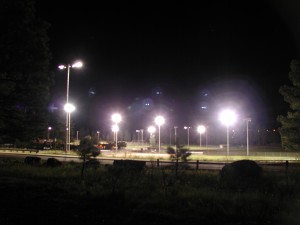Flagstaff’s Thorpe Park — the right light at last!
Sports lighting – a challenge.
Lighted sports fields are a part of most medium-sized and larger communities. Intense activity, often with many spectators, and high-speed balls require intense lighting. The impacts of this lighting “off the field” can and usually do extend far and wide: spill light into the sky from this lighting can be 30% or more of the spill from all outdoor lighting. When it’s on sports lighting is often the single largest producer of light pollution in our communities.
But these impacts can be dramatically reduced.
The Flagstaff Thorpe Park ballfields at the base of Lowell Observatory’s Mars Hill have new (as of July, 2007) Class IV lighting, and everyone is thrilled. FDSC was an advocate for this upgrade to replace the old unshielded fixtures that for over thirty years spread light into surrounding residential areas, lit up the side of the historic Lowell Clark telescope dome half a mile away, and unnecessarily polluted Flagstaff’s beautiful starry nights.
The process by which this improvement was accomplished shows a way for all communities to dramatically reduce the adverse impacts of this kind of lighting.
The new lighting conforms to “recommended practice” by the Illuminating Englineering Society of North America (IESNA) for recreational ballfields such as those at Thorpe Park. Class IV lighting calls for 30 footcandles in the infield and 20 in the outfield.
Brighter Class III lighting was recommended by the City of Flagstaff Parks and Recreation Commission, but IESNA only recommends this level (50 footcandles in the infield and 30 in the outfield) when there is deep seating for spectators who need more light on the field in order to have adequate visibility of the action at a distance. Thorpe Park has only a few rows of bleachers for spectators, so Class IV was clearly the right choice.
Oddly, the American Softball Association recommends Class III for tournament play (as does Little League). Since IESNA sets the standards, why does the ASA recommend a different standard? FDSC posed this question in a phone call to Mr. Del Armstrong, the former chair of the IESNA committee on sports lighting, and received a rather startling answer. It turns out that the original IESNA Recommended Practice for Sports and Recreational Area Lighting (IES RP-6 1988) contained an error. Mr. Armstrong explained in a letter to us that in a chart summarizing the recommended lighting for different classes of play and facilities, “It was intended that class IV be shown as suitable for … [among other applications] High Schools and Amateur Leagues. The ‘check mark’ was left off for High Schools and Amateur Leagues.” (Read the Armstrong Letter.)
Unfortunately, the error was not noticed until many years later, and organizations such as the ASA and Little League, with assistance from a light fixture manufacturer, developed their own recommendations based on the faulty chart. Today many amateur-level ballfields all over the country are significantly overlit. As Mr. Armstrong puts it in his letter, “This has turned out to be quite a significant error.”
The Flagstaff City Council took public testimony on the issue at their work session on August 7, 2006, giving informed citizens the opportunity to present the case for following the recommendations of IESNA. To their great credit, on Tuesday, August 15, the Council overturned the recommendation of the Parks and Recreation Commission and voted in favor of using Class IV lighting at Thorpe Park. Everyone is better off for it – from the ball players to the tax payers and stargazers. All Win!


